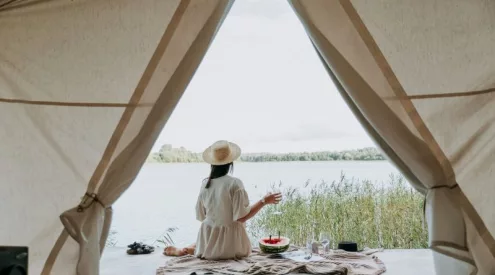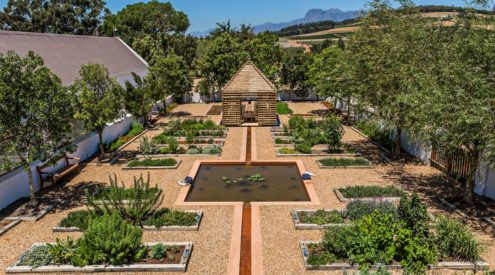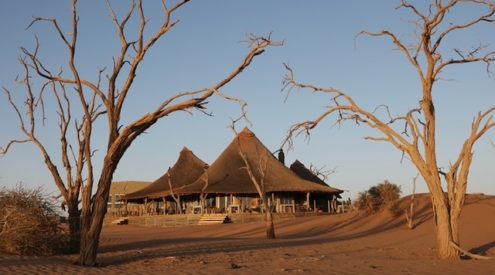Maasai meets Versailles
‘Welcome to our castle!’ exclaimed Albin – manager of the North Camp at Ngorongoro Crater Lodge. The collection of clay-coloured chimneys peaking out from behind wild fig and strangler trees looked like turrets, although the thatched roofs from whence they came appeared more rustic than royal. In complete contrast to the bungalows’ modest exteriors, no expense was spared in the design of the interiors. Whitewashed archways, mahogany walls, silk drapings, fine gold filigree and crystal chandeliers epitomised the dining area and cigar lounge. Our bungalows boasted the same over-the-top décor, each with a Victorian bath, fireplace and four-poster bed. Within view of the bathroom window stretched all 260 sq kms of the Ngorongoro Crater.
Down into the crater
Although we had two nights at the lodge, we decided to spend just one full day in the crater. Each visit into the Ngorogoro National Park costs $200 per car, sweetening the prospect of spending our first day by the fire, sipping sherry. Casmir, our ranger, met us early the next morning (picnic basket packed and ready), noting the glorious weather with a sparkle in his eye. A storm had passed during the night, filling the large lake at the base of the crater so that it reflected the candyfloss clouds floating above.
A fog had settled over the thick forest around the rim of the crater and we sat above it for a while, admiring the hundreds of swallows swooping in and out of the cottony mess. We idled slowly down the 600 m descent, stopping at one of the park’s three official toilets, where a gathering of eight morans (Maasai warriors) tried to sell us their beaded wares. ‘They’re not allowed to be here,’ commented Casmir. ‘If park officials were to come down, they’d have to run and hide. Only when water is scarce are they allowed to bring their cattle down to graze but they come to sell jewellery because drought has reduced their number of cattle and goats. They need the money.’ It seems all traditions, no matter how old, are vulnerable to change.
Half a decade or so ago, we would have seen more than a few Maasai herding their cattle through the crater. Now there are only wild animals. Within the first few hours, we’d come across four of the Big Five. The first was Babu, the oldest elephant in the crater with perfectly curved one-and-a-half metre tusks to prove it. A pair of black rhinos (mother and child) were kind enough to cross or path, their charcoal torsos silhouetted perfectly against the endless green of the crater floor. ‘We have thirty-six of them in the park,’ noted Casmir. ‘After a poaching spree in the sixties, only seven remained, so we are lucky to have so many today.’ I thought of our own rhino-poaching crisis in South Africa, angered by the greed that brings these rare creatures to slaughter.
Our next celebrity sighting was a cheetah feasting nervously on a freshly caught gazelle. She peered regularly out from behind her kill – adamant about spotting any would-be thieves before they spotted her. As if one cat wasn’t enough, we stumbled across a group of four young lions – still too innocent to compete for superiority. We watched in glee as they butted heads playfully, their crimson tongues wagging to beat the heat. After a while, the sun’s rays became too much and they sauntered over to the shrub-framed lakeshore across the road from where our vehicle was parked. One looked straight up at us as he rubbed his golden torso against the front door, then disappeared into the bush, not bothering to look back. Herds of buffalo, reaching sizes of up to 200, were always visible – grazing happily on the fertile grassland.
Although magnificent to watch, it wasn’t only the famous five that made the crater so special. Warthog, zebra, wildebeest, impala and bushbucks were everywhere you looked – far less skittish than the game of the Serengeti. Strength in numbers, I imagine. Then there were birds – thousands of them. Lilac-breasted and European rollers, showing off their brilliant colours as they darted from bush to tree. Hoards of lesser flamingos, quilting part of the algae-rich lake in their dazzling pink. Marabou stalks, vultures and yellow-billed kites circling the skies. Sunbirds, bee-eaters and weavers perched on delicate tree branches. Wherever you looked, the crater was always in motion.
A farewell fit for a king
After nine hours in the crater, we arrived back at the lodge cheerful and exhausted. This was to be the last night of our East African &Beyond safari. True to form, the staff made sure we left feeling like royalty. In each of the three bungalows that our travelling party occupied a hot bubble bath had been run, red rose petals were scattered around and a bottle of Prosecco was chilling on ice. We all arrived at dinner pink-cheeked and exuberant, saluting Tanzania as one of the world’s greatest holiday destinations.
















